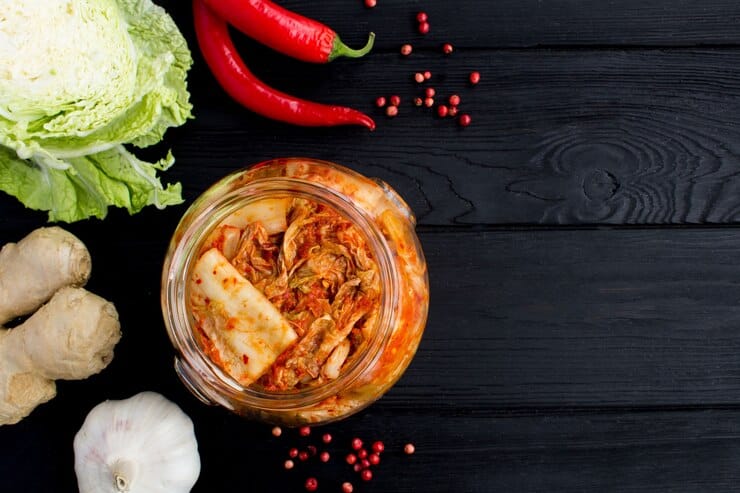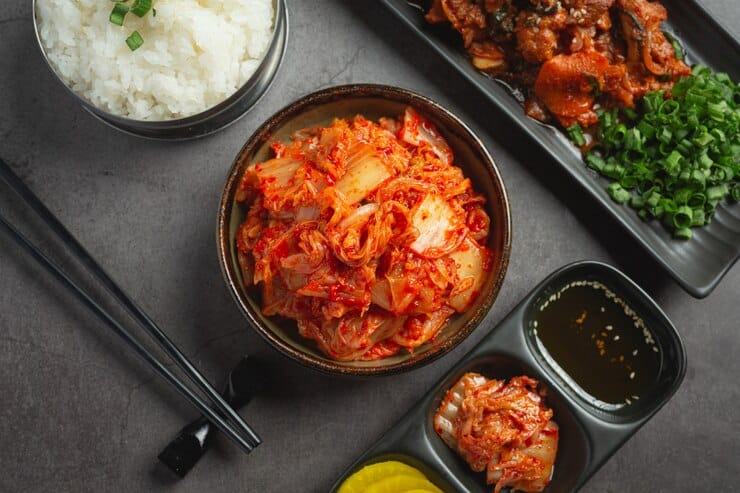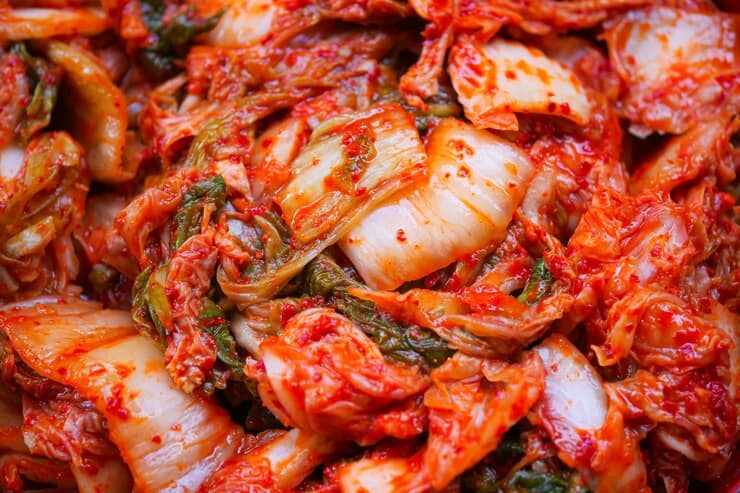Kimchi, a spicy Korean side dish, is a staple in Korean cuisine. It’s made with fermented vegetables, primarily napa cabbage, and a spicy chili pepper paste. This classic Korean recipe is packed with flavor and health benefits, making it a popular dish to be included in your paleo vegan lifestyle in 2024.
Ready to dive into the world of kimchi? This recipe will guide you through the process of making your own delicious kimchi at home as part of becoming a vegan. From selecting the right ingredients to mastering the fermentation technique, this comprehensive guide has everything you need to create a batch of kimchi that’s as good as any you’ve had in a restaurant.
What is Kimchi/Kimchee?
Kimchi, also spelled kimchee, is a vibrant and versatile side dish that’s a cornerstone of Korean cuisine. This national treasure is made with napa cabbage, a cruciferous vegetable similar to bok choy, that undergoes a fermentation process using chili flakes, garlic, ginger, and other seasonings. This fermentation not only preserves the cabbage but also imbues it with a complex flavor profile – a delightful blend of spicy, tangy, and savory notes.
While napa cabbage is the most common base, the world of kimchi extends far beyond. Different regions in Korea boast unique variations, incorporating vegetables like radishes, scallions, and even cucumbers. Seasonings can also vary, with some kimchi boasting a stronger seafood flavor thanks to the addition of shrimp paste. Whether you prefer a fiery kick or a more subtle experience, there’s a perfect kimchi out there waiting to be discovered!
How to Make Korean Kimchi?
Let’s embark on a culinary adventure to create a batch of authentic Korean kimchi. This homemade recipe is not only delicious but also a great way to customize the spice level and fermentation time to your liking.
Ingredients:
For the Kimchi:
- 1 large head of Napa cabbage, cut into 1-inch pieces
- 1/2 cup coarse sea salt
- 1 cup water
- 1/2 medium onion, chopped
- 1/2 cup garlic, minced
- 1/2 cup red pepper powder (gochugaru)
- 1/4 cup fish sauce
- 2 tablespoons sugar
- 1 bunch green onions, chopped
Instructions:
- Prepare the Cabbage: In a large bowl, combine the Napa cabbage with the salt and water. Massage the mixture until the salt is evenly distributed. Let the cabbage sit for 1-2 hours, or until it becomes soft and wilted. Rinse the cabbage thoroughly with cold water to remove excess salt.
- Make the Kimchi Paste: In a separate bowl, combine the onion, garlic, red pepper powder, fish sauce, sugar, and green onions. Mix well to form a paste.
- Assemble the Kimchi: Stuff the kimchi paste between the cabbage leaves. Pack the stuffed cabbage tightly into a clean, sterilized jar. Press down on the cabbage to release any air bubbles.
- Ferment the Kimchi: Cover the jar with an airtight lid and let it ferment at room temperature for 2-3 days. After the initial fermentation, transfer the jar to the refrigerator to slow down the process.
Tips:
- For a milder flavor, reduce the amount of red pepper powder.
- Adjust the fermentation time to your preference. A longer fermentation period will result in a more sour and flavorful kimchi.
- Store the kimchi in the refrigerator for up to 6 months.
Enjoy your homemade kimchi with a variety of dishes, from rice and noodles to soups and stews.

Vegan Kimchi: A Flavorful, Plant-Based Delight
This vegan kimchi recipe captures the essence of the traditional dish without compromising on flavor. It’s a perfect way to incorporate a healthy dose of probiotics into your diet.
Ingredients:
- 1 large head of Napa cabbage, cut into quarters
- 1/4 cup sea salt
- 1/4 cup Korean red pepper flakes (gochugaru)
- 2 tablespoons sugar
- 3 cloves garlic, minced
- 1 inch ginger, grated
- 3 tablespoons soy sauce or tamari
- 2 green onions, chopped
- 1 carrot, julienned
Instructions:
- Prepare the Cabbage: In a large bowl, combine the Napa cabbage with salt and massage it well. Let it sit for 1-2 hours, or until the cabbage becomes soft and wilted. Rinse the cabbage thoroughly with cold water to remove excess salt.
- Make the Kimchi Paste: In a separate bowl, mix the red pepper flakes, sugar, garlic, ginger, and soy sauce or tamari to form a paste.
- Assemble the Kimchi: In a large bowl, combine the cabbage, carrot, and green onions. Pour the kimchi paste over the vegetables and mix well until evenly coated.
- Ferment the Kimchi: Pack the kimchi tightly into a clean, sterilized jar, pressing down to remove any air pockets. Leave some space at the top to allow for fermentation. Cover the jar with an airtight lid and let it ferment at room temperature for 1-3 days, or until it reaches your desired level of sourness.
- Store the Kimchi: Once fermented, transfer the kimchi to the refrigerator to slow down the fermentation process. Enjoy your homemade vegan kimchi with rice, noodles, or as a side dish.
What is the best kimchi in Korea?
The beauty of kimchi lies in its diversity, with countless regional variations. While many Koreans swear by homemade kimchi, certain regions are renowned for their exceptional quality. Jeonju, for instance, is famous for its Baek Kimchi, a milder variety that emphasizes the natural sweetness of the cabbage. Ultimately, the “best” kimchi is a matter of personal taste, but exploring different styles is a delightful culinary journey.
Napa cabbage kimchi, or baechu kimchi, is undoubtedly the most ubiquitous type of kimchi in Korea. It’s a staple in Korean households and restaurants, loved for its balance of spicy, tangy, and savory flavors.
Can American cabbage be used as a substitute?
While American cabbage can be used as a substitute for Napa cabbage, it won’t yield the same results. Napa cabbage has a unique texture and flavor that is essential for authentic kimchi. American cabbage may lack the crispness and sweetness of Napa cabbage, resulting in a less flavorful kimchi.
Can I substitute red pepper powder with gochujang?
No, it’s not recommended to substitute red pepper powder with gochujang. While both ingredients are made from chili peppers, they have distinct flavors and textures. Gochujang is a fermented chili paste that adds a complex, savory flavor to dishes. Red pepper powder, on the other hand, provides a more straightforward spicy kick. Using gochujang as a substitute would significantly alter the taste and texture of the kimchi.
Can regular salt be used for Kimchi?
While you can technically use regular table salt for kimchi, many people prefer coarse sea salt for several reasons:
- Texture: Coarse sea salt helps to draw out moisture from the cabbage more effectively, resulting in a crispier texture.
- Flavor: Sea salt can add a subtle, natural flavor to the kimchi.
However, if you only have table salt on hand, you can still make delicious kimchi. Just be sure to adjust the salting time and rinse the cabbage thoroughly to remove excess salt.
What if I don’t have red pepper powder for Kimchi?
Red pepper powder, or gochugaru, is a key ingredient in kimchi and is essential for its authentic flavor and color. While it’s possible to make a less traditional version of kimchi without it, it won’t be the same.
Unfortunately, there’s no perfect substitute for red pepper powder. Other chili powders, like cayenne pepper or chili flakes, can add heat, but they won’t provide the same complex flavor profile.
If you can’t find red pepper powder, consider experimenting with different chili peppers or other spices to create your own unique kimchi.

How does Kimchi taste?
Kimchi offers a complex and dynamic flavor profile that can captivate the taste buds. Its distinctive taste is a result of a harmonious blend of:
- Umami: A savory, rich flavor that develops during fermentation.
- Spicy: A fiery kick that can range from mild to intense, depending on the amount and type of chili peppers used.
- Sour: A tangy, acidic taste that is a hallmark of fermented foods.
The specific balance of these flavors can vary significantly based on the choice of vegetables, such as napa cabbage, radish, or cucumber, can influence the overall taste. The combination of chili peppers, garlic, ginger, and fish sauce imparts a unique flavor profile to each kimchi variety. Also, the longer the fermentation process, the more pronounced the sour and umami flavors become.
While some people may find the sour and spicy flavors of kimchi to be an acquired taste, many others are drawn to its bold and complex flavor profile.
Why Homemade Kimchi Tastes Better
There’s something truly special about homemade kimchi. It’s fresher, more flavorful, and often more nutritious than store-bought varieties. By making your own kimchi, you have complete control over the ingredients and the fermentation process.
Here are a few reasons why homemade kimchi is superior:
- Customization: Tailor the recipe to your preferences, adjusting the level of spice, sourness, and sweetness.
- Fresh Ingredients: Use high-quality, fresh ingredients to ensure optimal flavor.
- Cost-Effective: Making kimchi at home can be more economical than buying it pre-made.
- Health Benefits: Homemade kimchi, free from preservatives, offers a healthier and more natural option.
- Satisfying Experience: The process of making kimchi is rewarding, and the end result is a delicious, homemade treat.
Is there a way to make homemade kimchi less sour?
To reduce the sourness of your kimchi, you can ferment the kimchi for a shorter period, either at room temperature or in the refrigerator. Before serving, rinse the kimchi with cold water to reduce the acidity. A small amount of sugar can help balance the acidity.
Is kimchi healthy?
Yes, kimchi is packed with health benefits! It’s a rich source of probiotics, which aid digestion, and vitamins like A and C, which boost immunity. Additionally, kimchi’s fiber content promotes gut health and can help regulate blood sugar levels.
Can I eat Korean kimchi every day?
Absolutely! Incorporating kimchi into your daily diet can be a fantastic way to boost your overall health. Just remember, moderation is key. Enjoy it as a side dish or incorporate it into various recipes.
Is Korean kimchi bad for cholesterol?
No, kimchi is not bad for cholesterol. In fact, studies suggest that the probiotics in kimchi may help lower cholesterol levels. So, feel free to enjoy this fermented delight without worrying about its impact on your heart health.
How long does Korean kimchi last?
The shelf life of kimchi can vary depending on storage conditions and the specific type. Generally, homemade kimchi can last for several months in the refrigerator. However, for optimal flavor and texture, it’s best to consume it within a few months.
How to know if Korean kimchi is spoiled?
Spoiled kimchi will exhibit certain signs. Look out for mold, an off-putting odor, or a slimy texture. If you notice any of these, it’s best to discard the kimchi immediately.
Should I keep Korean kimchi in the fridge?
Yes, refrigeration is crucial for preserving kimchi. It slows down the fermentation process, preventing it from becoming overly sour or developing unwanted flavors.
For How Long Should Kimchi Be Fermented?
The fermentation time for kimchi can vary depending on your desired level of sourness and spiciness. Typically, kimchi is fermented for 1-3 days at room temperature or 21 days in the refrigerator.
Room Temperature Fermentation:
- 1-3 days: Mildly fermented kimchi with a balanced flavor profile.
- Longer: More intensely fermented kimchi with a stronger, tangy flavor.
Refrigerator Fermentation:
- 21 days: A slower fermentation process, resulting in a milder flavor.
Storage and Shelf Life:
- Refrigerated: Kimchi can be stored in the refrigerator for up to 6 months. However, the flavor will continue to develop over time.
- Opened: Once opened, kimchi can be kept in the refrigerator for up to a week.
Dealing with Overly Sour Kimchi: If your kimchi becomes too sour for your taste, you can still enjoy it by:
- Mixing it with other dishes: Add it to soups, stews, or stir-fries to balance the acidity.
- Using it as a marinade: The tangy flavor can complement meats and vegetables.
- Fermenting it further: If you prefer a stronger, more pungent flavor, allow the kimchi to ferment for longer.
What type of jar should I use for Kimchi?
Wide-mouth glass jars are ideal for storing kimchi. They make it easy to pack the kimchi tightly and to retrieve it without damaging the vegetables. When choosing jars, ensure they are clean and sterilized to prevent contamination. Glass jars are preferred over plastic containers, as they are less likely to react with the acidic kimchi.

Top Cookbooks for Kimchi Enthusiasts
Whether you’re a seasoned home cook or a novice in the kitchen, these cookbooks offer invaluable insights into the world of kimchi.
For Beginners:
- Maangchi’s Real Korean Cooking by Maangchi: Renowned for her approachable style, Maangchi’s cookbook provides clear and concise instructions for making various types of kimchi, from classic napa cabbage to unique variations.
- Korean Food Made Simple by Judy Joo: This book offers a modern take on traditional Korean cuisine, including kimchi. Joo’s step-by-step instructions and helpful tips make it easy to achieve delicious results.
For Advanced Home Cooks:
- Korean Home Cooking by Sohui Kim: This in-depth cookbook explores the cultural significance of kimchi and provides detailed recipes for various styles. Kim’s expertise shines through, making it a valuable resource for serious home cooks.
- The Kimchi Chronicles by Marja Vongerichten: This book offers a personal and cultural perspective on kimchi, blending traditional recipes with modern twists. Vongerichten’s engaging storytelling and expert advice make it a delightful read for kimchi enthusiasts.
With these cookbooks as your guide, you’ll be well on your way to mastering the art of making delicious and authentic kimchi.
Top 3 Kimchi Recipe Cookbooks
1. The Kimchi Cookbook: 60 Traditional and Modern Ways to Make and Eat Kimchi
This comprehensive cookbook offers a diverse range of kimchi recipes, from classic to contemporary. It’s perfect for both beginners and seasoned cooks, providing clear instructions and mouthwatering photos.
Key Features:
- A wide variety of recipes, including vegan and vegetarian options
- Step-by-step instructions and helpful tips
- Beautiful photography to inspire your cooking
Price: Around AUD $30
Sales: Over 100,000 copies sold globally
2. The Kimchi Chronicles: Korean Cooking for an American Kitchen: A Cookbook
This cookbook bridges the gap between Korean and American cuisine, offering accessible and delicious kimchi recipes. It’s perfect for those who want to experiment with Korean flavors in their own kitchen.
Key Features:
- A mix of traditional and modern recipes
- Easy-to-follow instructions and stunning visuals
- A cultural exploration of Korean cuisine
Price: Around AUD $35
Sales: More than 50,000 copies sold worldwide
3. The Korean Kimchi Cookbook: 78 Fiery Recipes for Korea’s Legendary Pickled and Fermented Vegetables
This cookbook is a deep dive into the world of kimchi, offering a wide range of spicy and flavorful recipes. It’s perfect for those who want to explore the bold flavors of Korean cuisine.
Key Features:
- A focus on traditional Korean kimchi recipes
- Detailed instructions and helpful tips
- Stunning photography to inspire your cooking
Price: Around AUD $40
Sales: Over 75,000 copies sold




